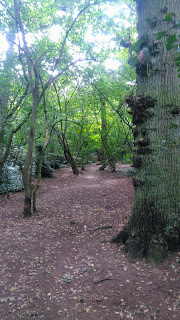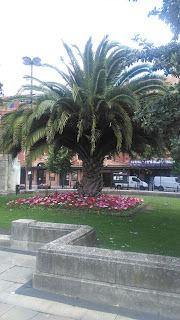My wargaming is almost as diverse as my interest in history, but my most-recent big project was the War of the Austrian Succession with 10mm armies of nine combatant nations. I have also recently played many scenarios from Mike Lambo's solo battle books, created Franco-Prussian War armies with plastic 54mm toy soldiers, and fought scenarios from Airfix Battles with plastic green-and-tan Army Men. My latest big project is Biblical battles in 10mm.
Thursday, November 05, 2020
Two More Mags
I found all the articles in Slingshot interesting, while Ancient Warfare could hardly go wrong by theming on Hellenistic war in Asia Minor.
Thursday, October 29, 2020
Another Entertaining Historical Read
SOME books have such cumbersome titles, and come with such an unprepossessing cover, that it is a wonder any copies are sold at all.
Such could easily be said of A Journey To The Tea Countries Of China Including Sung-Lo And The Bohea Hills; With A Short Notice Of The East India Company's Tea Plantations In The Himalaya Mountains.
Written by a Scottish botanist, Robert Fortune, it was originally published in 1852.
My copy is a facsimile by Miami-based HardPress, who "are offering thousands of classic and hard to find books."
The title sums up the contents very well and, apart from rather too much detail about the plants he discovered, I found it a fascinating read of a journey, most of which he had to take in disguise to avoid detection by the Chinese authorities, through a bygone culture.
I certainly intend buying his earlier book, Three Years Wanderings In The Northern Provinces Of China.
Wednesday, October 14, 2020
Great Read
"The notable success of Travels In West Africa was due in no small part to the vigour and droll humour of writing ... in the guise of a ripping yarn," states her entry in Wikipedia.
The encyclopaedia continues: "Kingsley's tales and opinions of life in Africa helped draw attention to British imperial agendas abroad and the native customs of African people that were previously little discussed and (were) misunderstood by the European people.
Friday, September 18, 2020
Good - But Could Be So Much Better
 |
| Colourful ... but there's something missing |
Wednesday, September 16, 2020
Toy Soldier Collector August/September 2020
Wednesday, September 09, 2020
Leisurely From Leisure Games
The last time I was in the shop, which was a good few years ago, I bought the boardgame Empires In America.
Not much has changed at Leisure Games, which is certainly not meant as a criticism, except that the shop seems to no longer stock magazines.
I guess this is largely down to the internet, although the Orcs (sic) Nest in Seven Dials still has a reasonably diverse magazine rack.
I did not buy anything at Leisure Games, but my trip gave me an excuse to spend much of the rest of the day walking back to Spitalfields.
This time, however, on reaching the North London Circular, instead of continuing south, I turned east on to the Dollis Valley Greenwalk - the signpost indicating that it went through Little Wood and Big Wood was a big attraction.
Parts of the walk were picturesque indeed, and even the urban bits were interesting.
I ended up at the Hampstead Heath Extension and eventually found my way to Hampstead Heath proper.
On leaving the heath I headed south, but then turned left towards Hampstead tube station and made my way home via a familiar route through Camden, stopping on the way for a late lunch-early dinner at a Portuguese restaurant called O Tino.
All in all a thoroughly enjoyable day, with plenty of scenic bits along the way.
Tuesday, September 08, 2020
Entertaining - But Off The Marc
I have read Polo's account of his travels from Italy to the far side of China, but Bergreen does a good job of adding interesting historical background.
Unfortunately not all of it is, to say the least, reliable.
Take this digression on silk: "It is possible that the Roman legions first encountered actual silk at the Battle of Carrhae, near the Euphrates River, in 53BC.
"It was said that the Parthians' vivid silk banners unfurling in the wind startled the Roman troops, who promptly fled the battlefield."
This is pure fantasy.
Or this vignette from a battle between Mongols and the King of Burma: "The two sides took each other's measure for several days, while Mongol military intelligence went to work.
"Mongol spies learned the length of the arrows used by the enemy, and made sure that their own warriors' arrows were shorter, so as to be incompatible with the enemy's in battle.
"This way, the enemy would be unable to reuse them in bows designed for a longer weapon."
More nonsense - if the Mongols' changed the length of their arrows in the days before a battle, where did they get the bows needed to fire the new-length arrows?
And then there is this: "It is difficult to imagine the Renaissance - or, for that matter, the modern world - without the benefit of Marco Polo's example of cultural transmission between East and West."
I could mention other sections that cry out for a good editor - a merely competent one would do - and I worry how much other nonsense I missed because my background knowledge on some subjects was not good enough to spot them.
And yet, despite these problems, I enjoyed the book and am glad I spent £14.99 on it.
 |
| Curate's egg |
Monday, September 07, 2020
North & South
Yesterday, for a change of pace, I walked to Moorgate tube station and caught the first Northern Line train that came along heading north.
I got off at West Finchley and, using the position of the sun as my main guide, headed home to Spitalfields.
The distance is 8.7 miles, according to Google Maps, but I certainly did not take the direct route, not least because I wanted to see if the Leisure Games shop is still open in central Finchley.
It is, but I was too early, so I had a coffee and continued south.
Along the way, just before the North Circular. I came across this somewhat saucy-looking statue, whose official name turns out to be La Délivrance.
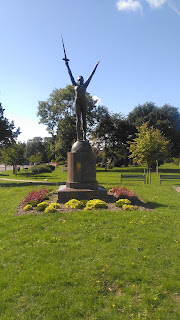 |
| La Délivrance - known locally as The Naked Lady |
In fact it seems this is the original statue - bought by Daily Mail owner Viscount Rothermere in 1920 and donated to Finchley Council as a memorial for World War One.
The plaque, with its claim of this being a copy, can be seen below.
 |
| The plaque |
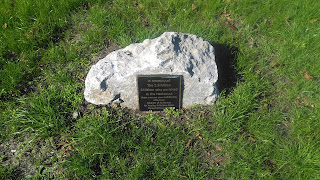 |
| Small, like many of the Germans' victims |
Thursday, July 30, 2020
When?
"A great deal of nonsense has been written about missionaries. When they have not been described as the servants of imperialists or commercial exploiters, they have been regarded as sexually abnormal types who are trying to convert a simple happy pagan people to a European religion and stunt them with European repressions. It seems to be forgotten that Christianity is an Eastern religion to which Western pagans have been quite successfully converted. Missionaries are not even given credit for logic, for if one believes in Christianity at all, one must believe in its universal validity. A Christian cannot believe in one God for Europe and another God for Africa: the importance of Semitic religion was that it did not recognize one God for the East and another for the West. The new paganism of the West, which prides itself on being scientific, is often peculiarly neurotic. Only a neurosis explains its sentimental lack of consistency, the acceptance of the historic duty of the Mohammedan to spread his faith by the sword and the failure to accept the duty of a Christian to spread his faith by teaching."
*****
*****
*****
*****
*****
*****
*****
*****
*****
*****
*****
To me it comes across as very modern, but is from Graham Greene's 1936 book Journey Without Maps.
I guess there are three clues that the writing is not modern:
a) using 'Mohammedan' rather than 'Muslim',
b) using 'recognize' rather than the modern UK English 'recognise',
c) defending Christianity rather than attacking it.
Friday, July 24, 2020
Thursday, July 23, 2020
A Knight To Remember
 |
| Thomas Asbridge's The Greatest Knight |
To describe him as The Greatest Knight might sound like hyperbole, but his life story really does seem like something out of an Arthurian romance, only better!
I will not give away details of what he achieved as I do not want to spoil the fun of reading the book for anyone who might follow my recommendation.
But, apart from a few minor quibbles I had from time to time as I raced through the almost-450 pages, I am very pleased I bought it.
Wednesday, July 22, 2020
Schloss Nidau
The first wooden castle on the site was apparently built in 1140, with a stone version following almost 100 years later.
The town of Nidau was not founded until the 14th century, but presumably there would have been some farming activity and work connected with the castle before then.
A river and water-filled moat surrounded the castle for many centuries, but disappeared due to major anti-flooding measures undertaken from 1868 in a region known as Swiss Seeland.
Monday, July 20, 2020
Swiss Treat
Saturday, July 18, 2020
Eyes Down, no Up
There is some truth in this - I once found a £20 note - but in London there is more to be seen if you keep your eyes on higher things.
The picture below shows The Chandos pub, which is approximately equidistant between Charring Cross, Trafalgar Square and Leicester Square.
Above it can be seen a working model of a breweryman, or possibly a pub worker, mandhandling a barrel, presumably of beer.
The barrel revolves and the man's head moves, but when it comes to action I have to say the astronomical clock at Olomouc in the Czech Republic is more animated, and I never thought I would have to say that.
Apparently there has been a pub on the site for more than 300 years, but the name has changed, it being called The Chandos, possibly after the Dukes of Chandos, since a rebuild in 1885.
Monday, July 13, 2020
Who He?
He is largely forgotten by the general public, but see if you can guess which of these two summaries of his life is the correct one.
1. MP - commanded militia that played a key role in suppressing the Gordon Riots - fathered at least two illegitimate children - magistrate.
2. Supported the rebels in the American War of Independence - jailed for insulting the king - radical journalist - declared an outlaw by the House of Lords.
The statue is of John Wilkes, and both these summaries of his life are correct, as can be seen in greater detail at https://en.wikipedia.org/wiki/John_Wilkes
Saturday, July 11, 2020
Where In The World?
I wonder if this is the type of place I could do with visiting?
Actually the answer is a definite No because I took this photo yesterday ... outside Hackney Town Hall in what I would call East London but I guess some might say is North London.
There is nothing very historic about the view or the site, but it cheered me, which is my excuse for reproducing the photo here.
Friday, July 10, 2020
Gone But Not (Quite) Forgotten
 |
| The statue yesterday |
It is in a poor state of preservation, including a baton in the king's right hand that is long gone and replaced, temporarily, by a flower.
According to Wikipedia the area used to be called King Square in Charles II's honour, but at one point was so neglected that it was even forgotten whom the statue was meant to represent.
Thursday, July 09, 2020
Standard Curry
For starters, as it were, the restaurant is run by people of Bangladeshi descent rather than Indian, although I guess Indian could be argued as correct if thought of geographically.
But the more interesting point is why this restaurant, and many others like it in Britain, is called Standard.
I have not been able to confirm this but I believe it goes back to the days of the British Raj, and specifically the East India Company.
Locals who wanted to sell products to the company, the story goes, had to have their goods certified as being up to standard, and so the word standard in Indian sub-continental English came to be associated with superior quality.
I cannot recall where I learnt this, but it at least sounds right ...
Wednesday, July 08, 2020
Ever Felt Like You've Been Cheated?
But through my letterbox today came the "Summer Double Issue" of Literary Review.
As if that were not bad enough, it seems to have been edited by idiots without a basic grasp of general knowledge.
For example, a review of three books on swimming states: "The ancient Greeks often triumphed in battle due to their swimming prowess."
On another page we are told someone "studied PPE at Oxford." Did no one think that in today's climate the letters PPE might mean something other than a university course for teens?
I renewed my subscription to Literary Review for another year yesterday. I doubt if I would have done it today.
Tuesday, July 07, 2020
Boswell & Johnson
Wandering through central London the other day I came across this ordinary-looking former bookshop on the edge of Covent Garden.
It turns out to be where James Boswell first met Dr Johnson, prompting the following famous exchange:
Boswell: "Mr Johnson, I do indeed come from Scotland, but I cannot help it."
Johnson: "That, Sir, I find, is what a very great many of your countrymen cannot help."
Boswell's Life Of Samuel Johnson is a great read, but I also thoroughly enjoyed his accounts of travelling through Corsica and, with Johnson, through Scotland.
All three books are definitely on my to re-read list.
Monday, July 06, 2020
Thomas Who?
If you reckon it looks unprepossessing from outside, you should have a peak through the front door.
It certainly is not the historic type of pub I was hoping would be my first after lockdown.
And yet it turns out that while the pub is modern, it commemorates someone from the 17th century who was a prominent man in his time but is very little known today.
Neale was a Master of the Mint - he was succeeded on his death in 1699 by Isaac Newton - and, according to Wikipedia, was at least partly responsible for developing major parts of London including Seven Dials, Shadwell and East Smithfield.
He apparently also invented special anti-cheating dice for use in gambling and was MP for Petersfield, which gives me a tenuous connection as that Hampshire town is where I went to grammar school.
I certainly did not get to drink my first post-lockdown pint in a historic pub, but the pub I ended up in meant I did come across some interesting history.
Sunday, July 05, 2020
Lockdown Over? Try Telling That To Drinkers!
I walked around much of Soho, Covent Garden, Holborn and parts of the East End, and overwhelmingly the picture was the same - most pubs remained shut.
Barbershops had queues outside, but bars were mainly closed. So much for "Super Saturday" ...
Saturday, July 04, 2020
Name That Flag
It is being flown daily outside the High Court in central London.
I thought it looked vaguely Macedonian but I could not place it so yesterday I went over and asked the man, politely, what he is up to.
It turns out he is giving evidence, as he put it, by standing opposite the main entrance to the court as there are "political" reasons why he is not allowed to give evidence inside.
The flag is a"parody" of the EU flag and is part of his comment on "the BBC - the Big Brexit Conspiracy."
I was unable to get details of the said conspiracy (admittedly I did not try too hard), but it is a nice-looking flag.
Friday, July 03, 2020
Independence Day
To be fair I have been in the US on that day and not seen many signs of celebrating - certainly not to the degree you might expect from films and TV.
However July 4 will certainly be widely celebrated in England this year as it is the day people regain much of their freedom lost under Covid-19 lockdown.
Pubs and restaurants were ordered to shut 15 weeks ago on the evening of Friday March 20.
I hope to mark their official reopening tomorrow with a few drinks and a meal, and by watching Wolves play Arsenal at 5.30 in a pub with Sky.
The one thing I have not decided is where I am going to do these things, but I feel my first pub should have some historical significance ...
Thursday, July 02, 2020
Another Covent Garden Gem
Actually it is a photo of fruit sellers in London's Covent Garden in 1973.
Wednesday, July 01, 2020
Vaduz Castle
Tuesday, June 30, 2020
Castle Fever
When I used to visit Liechtenstein annually to play in a chess tournament and walk in the mountains, I would almost always ensure each day's walk went past a castle on a hill overlooking the capital Vaduz.
It is owned by the Liechtenstein royal family and is not open to the public, but I would happily sit on a nearby wooden fence and spend 10 minutes or so just looking at it.
Today I visited Hamleys in Regent Street for the first time since the Covid-19 lockdown began.
I did not come close to buying anything, but I was pleased to see this:
 |
| Little things ... |
Monday, June 29, 2020
History On My Doorstep
I felt sure I must have seen it before - I have passed near the spot hundreds of times - but apparently without my curiosity being sufficiently aroused to investigate further.
A short walk down a winding alley brought me to the church in question.
The original dates from 1550 and, according to Wikipedia, is the oldest Dutch-language Protestant church in the world.
Indeed, again according to the online encyclopedia, the Nederlandse Kerk is recognised in the Netherlands as the mother of all Dutch reformed churches.
It is built on land, formerly owned by Augustinian friars, given by Edward VI for "Germans and other strangers" who had fled Roman Catholic persecution.
The first superintendent of the congregation was a Pole, Jan Łaski, but Dutch speakers soon dominated.
German planes destroyed the building in 1940, the day after the church's collection of Dutch bibles and other rare books had been removed for safekeeping.
The church, which was rebuilt in the early 1950s, is believed to contain the site of the burial place of the remains of the executed pretender Perkin Warbeck.
Sunday, June 28, 2020
More Attlee
Saturday, June 27, 2020
Name That Year
Friday, June 26, 2020
Golden Oldie
But, despite being a subscriber, I cannot recall much along those lines - mostly the magazine is full of old-ish people commenting on present-day matters.
But the July issue, which came through my letterbox earlier this week, has a piece of historical interest on post-WW2 prime minister Clement Attlee.
Biographer Francis Beckett writes: "At one of his press conferences, which was running into the ground after 10 minutes because of the prime minister's monosyllabic answers, a journalist who knew him well said, 'Prime Minister, we're all stumped - what's 12 across, two words, seven and six letters?' And Attlee talked for 10 minutes about how he had solved the clue from that morning's Times crossword."
The anecdote strikes me as being at least embellished, and almost certainly apocryphal (10 minutes is a long time to talk about one clue), but enchanting none-the-less.
Thursday, June 25, 2020
Winning A VC By Popular Vote
It sounds far-fetched, but apparently it used to happen.
I only found out about it after coming across this striking memorial, to Able Seaman Albert McKenzie, beside Tower Bridge Road in Bermondsey, South London.
He took part in a raid on Zebrugge in German-occupied Belgium in April 1918 in which most of the storming party of which he was a member were killed.
According to Wikipedia, 19-year-old McKenzie "landed with his machine-gun in the face of great difficulties, (accounting) for several of the enemy ... and was severely wounded whilst working his gun in an exposed position."
McKenzie was presented with his VC by George V at Buckingham Palace, only to die later in the year from Spanish Flu.
So far, interesting enough, but not especially remarkable, and there is no mention of there being a ballot before McKenzie was awarded his medal.
However, go to the Wikipedia entry for the Zeebrugge Raid, as opposed to the entry for McKenzie, and this can be found:
"The Zeebrugge Raid was promoted by Allied propaganda as a British victory and ultimately resulted in the awarding of eight Victoria Crosses. The 4th Battalion Royal Marines was awarded the Victoria Cross for the action. Under Rule 13 of the Victoria Cross warrant, a ballot was stipulated [to] select the recipients. Victoria Cross rules specify that four Victoria Crosses should be awarded this way (one to an officer, one to an NCO and two to other ranks) they were not observed and only two Victoria Crosses were awarded. This was the last time that Victoria Crosses were awarded by ballot, although the rule remained within the Victoria Cross warrant. In a mark of respect to those involved in the raid the Royal Marines have never raised another 4th Battalion. A ballot was similarly held for the crews of the assault vessels for the Zeebrugge Mole (Vindictive, Royal Daffodil and Iris II) and the embarked raiding parties. Following the ballot, Victoria Crosses were awarded to Albert Edward McKenzie and Alfred Carpenter."
Wednesday, June 24, 2020
Towering Holes
 |
| Tower Of London with the Walkie-Talkie Tower looming in the background |
Tuesday, June 23, 2020
History Today July 2020
It concentrates on the famous meeting between Henry VIII of England and Francis I of France in June 1520.
This is usually known as The Field Of The Cloth Of Gold, although in History Today it is rendered less smoothly as The Field Of Cloth Of Gold.
 |
| (The) Magazine |
It only happened in small numbers, and apparently never affected who won a seat in the Commons, but made for amusing reading.
Monday, June 22, 2020
Refighting Hohenfriedberg (part 10)
2pts for a win, plus a bonus point if the win reverses a battle's historical outcome
PLAYERS
Wins Losses Bonus Points Total Points Score*
Me 5 2 4 14 100%
Opponent 2 5 1 5 35.7%
NATIONS
Austria 5 0 4 14 140%
France 2 2 1 5 62.5%
Britain+ 0 2 0 0 0%
Prussia 0 3 0 0 0%
*Score is calculated on the basis that two points a battle counts as 100 percent, so it is possible with bonus points to score up to 150 percent.
+This is the Pragmatic Army, which was led and primarily financed by Britain.
Sunday, June 21, 2020
Refighting Hohenfriedberg (part nine)
 |
| Looking from behind the Austro-Saxon left at the start of turn 11 |
Frederick again won the initiative, and rolled 2+1 (centre) and 4 (right).
He had to use one of his centre action-points to try, successfully, to rally the Porzellan Dragoons and another to try, unsuccessfully, to rally the Samuel von Schlichting Foot. He used the third one to get the Margrave von Bayreuth Dragoons to charge my Fürst von Batthyány Dragoons, winning the subsequent melee by two hits to one, which eliminated my squadron. On the right he was able to move all four remaining units, but this did not result in any combats.
After 10.5 turns the Prussians have lost 17 of 34 army points and the Austro-Saxons have lost 19 of 40.
I rolled 4 (left), 6 (centre) and 5 (right).
It only took one action point to finish the battle, when my Saxon artillery battery scored a hit on the Johann von Hertzberg Foot, which had already been reduced to 25% effectiveness and so was now eliminated. That meant Frederick had lost 19 action points - more than half his starting total, and therefore meaning he had lost the battle.
 |
| Frederick looks a lonely figure in the distance as the fleeing Samuel von Schlichting Foot rush past him |
Saturday, June 20, 2020
Refighting Hohenfreidberg (part eight)
 |
| Overview from behind the Austro-Saxon left st the start of turn nine |
The situation looks grim for Frederick, but yet again he won the initiative, and rolled 9+1 (centre) and 5 (right) - no units of the Prussian left remain.
On his right the Hacke-Leps Grenadiers pivoted round Pilgramshain and fired a volley at the Niesemeuschel Foot, who immediately lost 50% effectiveness, and the unit lost a further 25% and had to flee when its morale failed. In the centre his artillery caused the Deutschmeister Foot to lose a further 25% effectiveness, meaning it is one hit away from complete disintegration, and the Johann von Hertzberg Foot scored a hit on the Prié-Turinetti Foot. Frederick pulled back the Samuel von Schlichting Foot from the Austro-Saxon centre, presumably not liking the odds of their survival. He also swung the Johann von Lehwaldt Foot away from the centre and towards my right, where the Porzellan Dragoons and Margrave von Bayreuth Dragoons had already been heading.
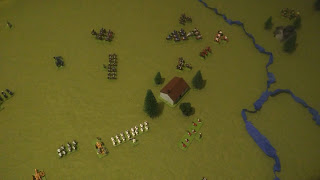 |
| Prussians attack the victorious Austro-Saxon right |
I rolled 6 (left), 6 (centre) and 3 (right).
On the left I was unable to rally either the Niesemeuschel Foot or the Prinz Xaver Foot, which meant both units left the battlefield. However the Prié-Turinetti Foot scored a hit on the Johann von Hertzberg Foot, evening the score in their long drawn-out musketry duel. In the centre my Karl von Lothringen Foot advanced passed the hamlet of Thomaswaldau and poured a devastating volley into the flank of the Johann von Lehwaldt Foot, causing the Prussians to lose 75% effectiveness, although their morale just about held firm (Frederick rolled a 2, but the presence of the Margrave von Bayreuth Dragoons counted as being a friendly unit to the rear, based on the direction of attack, and so provided a +1 modifier, raising the Johann von Lehwaldt Foot's morale to the 3 needed by regular units). On my right the triumphant Porzellan Dragoons were charged in front and both flanks. In all I was entitled to eight dice, but scored just two hits. However that was enough to win the melee as the Prussians inflicted only one hit. The Prussians had to flee, but my victory was somewhat pyrrhic as the one Prussian hit was determined by rolling dice to have fallen on the much-reduced Eugen von Savoyen Dragoons, who were therefore eliminated.
After nine turns the Prussians have lost 15 of 34 army points and the Austro-Saxons have lost 18 of 40. In other words both sides are just three points away from losing more than half their starting total, and therefore the battle.
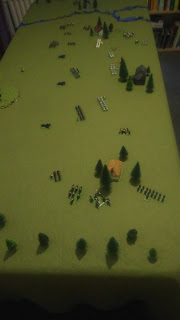 |
| Lots of Prussians in the foreground but most Austrians are concentrated between Günthersdorf and Thomaswaldau |
 |
| Overview of the delicately balanced battle at the end of turn 10 - getting the initiative next turn could be decisive |





